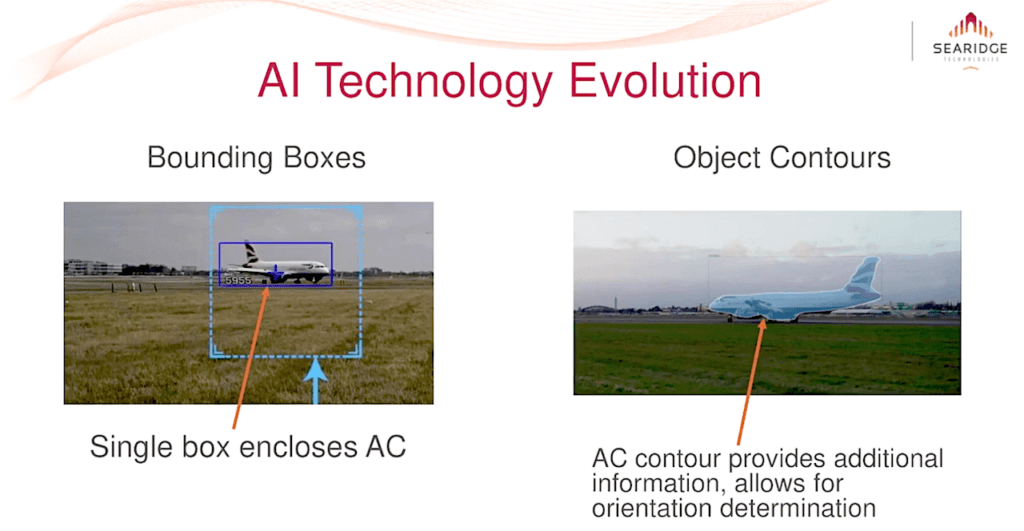
Searidge Technologies’ Aimee artificial intelligence and machine learning platform is unlocking new use cases for AI at airports and air traffic management systems. Photo: Searidge Technologies
Artificial intelligence (AI) and machine learning are already revolutionizing air traffic management (ATM), with the potential to support more use cases in the future according to a June 24 Global Connected Aircraft Cabin Chat on Artificial Intelligence in Aviation.
“AI has revolutionized the way we manufacture systems for air traffic management,” said Marco Rueckert, head of innovation at Ottawa-based Searidge Technologies. “We don’t aim to replace the human air traffic controller, but what we’re really trying to do is enhance the capability of the human by providing situational awareness and decision support tools so the human can do their job more effectively, taking away some of the mundane tasks so that they can focus on the more complex decisions.”
Challenges in developing such AI systems for aviation include the safety critical nature of aviation; the validation of AI performance, including understanding failure modes; verification that the use of AI is safe; and understanding how AI makes decisions. Since Searidge Technologies’ work on AI began in 2012, the company has learned that not all data for AI is useful, and that the data for AI has to be pre-processed and labelled, not dumped in expectation of an output, Rueckert said.
Searidge’s AI platform, Aimee, is capable of simplifying the process of configuring and training artificial neural networks with the large and complex data sets that enable the use of AI for things like image and geo-location tracking of an aircraft to ensure that a runway is ready for the next aircraft in sequence to land. At London’s Heathrow International Airport, it is already being used as a way of replacing air traffic controller views of the runway when the tower’s vision is lost due to clouds or fog.

Controllers get the same alert and see the same aircraft label for every aircraft monitored by Aimee. When an aircraft clears the runway safety strip, Aimee instantly alerts controllers that the runway is cleared for the next arrival. Photo: NATS UK
The world’s first 4K digital tower lab at London’s Heathrow International Airport was co-developed by Searidge with a goal to recover 20 percent of lost landing capacity at the airport that occurs due to low visibility conditions. Nine 4K cameras on the north side of the tower and nine 4K cameras on the south side provide runway coverage. AI comes into play when inclement weather impedes a controller’s view of the runway from the 100 foot tall tower at Heathrow.
The images from those cameras are then fed live into Aimee, which can interpret the images, track the aircraft and then inform the controller when it has successfully cleared the runway. The controller then makes the decision to clear the next arrival. Building such AI-powered capability required a fusion of different data sets and the use of Aimee to correctly help controllers distinguish between different aircraft types, according to Rueckert.
“What sometimes happens is because the radar is at a 1 Hz update rate and the visual system is at 25 Hz, the radar source either lags or behind or is a little inaccurate in the triangulation. So we use the radar as the initial source and use the AI to correct,” Ruckert said.
Searidge trialed the AI system over three months, tracking 50,000 aircraft movements.
“Now we’re looking for a business case to roll this out at all the exits in London Heathrow,” Ruckert said.
Other airports and air traffic management systems elsewhere in Europe are also poised to see the adoption of AI technology in the future as well. In 2019, Eurocontrol held its inaugural forum on aviation and AI, that lead to the publishing of their first “Fly AI” report in March 2020. The report outlines how air navigation service providers, airlines, airports and other stakeholders across the European air traffic ecosystem see the potential use of AI for better use of aviation data leading to more accurate predictions and more sophisticated tools.
Some of the first ATM applications for AI featured in the report are air traffic control planning and flow management, where Eurocontrol trials already show a 30 percent improvement in trajectory prediction. Eurocontrol also sees the potential use of AI in helping establish surveillance technology for drones operated commercially beyond visual line of sight in European airspace.

At Dubai International Airport, Aimee is comparing real time data and events associated with aircraft turnaround times, with historical data to predict and prevent delays. Photo: Searidge Technologies
Searidge has also been infusing AI into the workflows at other airports, focusing on making the aircraft turnaround process more efficient for both airlines and airport workers. At Dubai International Airport, Aimee tracks and detects certain personnel and events associated with a typical aircraft turnaround process in real-time, to include monitoring of jet bridge movements, catering trucks and service vehicles among other workflows. That data is then compared with historical data associated with the same events, to predict whether an aircraft will meet its scheduled departure time.
In the future, Ruckert believes a key focus for Searidge and others integrating more AI capability into air traffic management could be the use of AI for communication between pilots and controllers.
“The space we’re really going into is voice, the primary communication between the pilots and air traffic controllers is still the radio channel, and its quite hard to hear especially when we go to the UK and work with NATS you have about 50 different accents in Scotland alone,” Ruckert said. “Not necessarily so that you just have the autonomous aircraft talking to the autonomous ATC, maybe not in five years but at least to some point where we can do some error checking and say you told this aircraft to go to runway 1 and it’s actually taxiing the wrong way. Just putting another safety layer in there.”